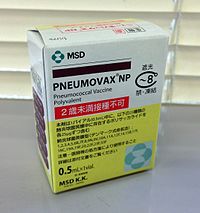
Photo from wikipedia
Non-invasive pneumococcal pneumonia (NIPP) is a frequent cause of morbidity and mortality worldwide. The 13-valent pneumococcal conjugate vaccine (PCV13) was included in the national immunization program of children living in… Click to show full abstract
Non-invasive pneumococcal pneumonia (NIPP) is a frequent cause of morbidity and mortality worldwide. The 13-valent pneumococcal conjugate vaccine (PCV13) was included in the national immunization program of children living in Portugal in 2015. Until then, PCV7 (since late 2001) and PCV13 (since early 2010) were given through the private market. We determined the serotype distribution and antimicrobial susceptibility of isolates causing adult NIPP in 2012–2015 and compared the results with previously published data (2007–2011). There were 50 serotypes among the 1435 isolates. The most common were serotypes: 3 (14%), 11A (8%), 19F (6%), 23A (5%), 6C (5%), 19A (4%), 23B (4%), 9N (4%) and non-typable isolates (4%). When considering data since the availability of PCV13 for children in the private market, the proportion of PCV13 serotypes declined from 44.0% in 2010 to 29.7% in 2015 (p < 0.001), mainly due to early decreases in the proportions of serotypes 3 and 19A. In contrast, during the same period, PCV7 serotypes (11.9% in 2012–2015) and the serotypes exclusive of the 23-valent polysaccharide vaccine (26.0% in 2012–2015), remained relatively stable, while non-vaccine types increased from 27.0% in 2010 to 41.9% in 2015 (p<0.001). According to the Clinical and Laboratory Standards Institute (CLSI) breakpoints, penicillin non-susceptible and erythromycin resistant isolates accounted for 1% and 21.7%, respectively, of the isolates recovered in 2012–2015, with no significant changes seen since 2007. Comparison of NIPP serotypes with contemporary invasive disease serotypes identified associations of 19 serotypes with either disease presentation. The introduction of PCV13 in the national immunization program for children from 2015 onwards may lead to reductions in the proportion of NIPP due to vaccine serotypes but continued NIPP surveillance is essential due to a different serotype distribution from invasive disease.
Journal Title: PLoS ONE
Year Published: 2018
Link to full text (if available)
Share on Social Media: Sign Up to like & get
recommendations!